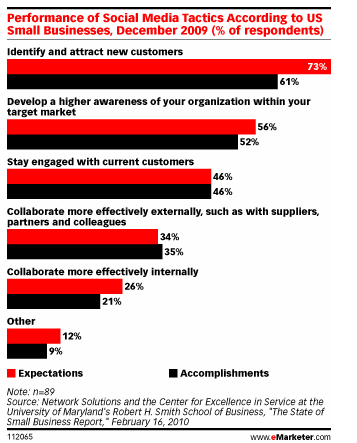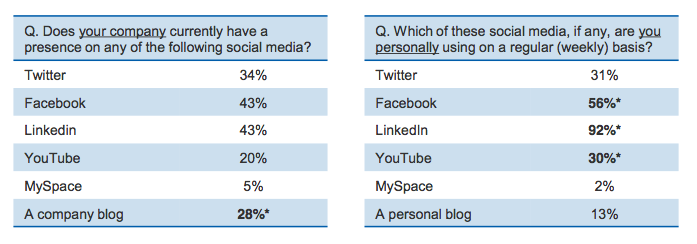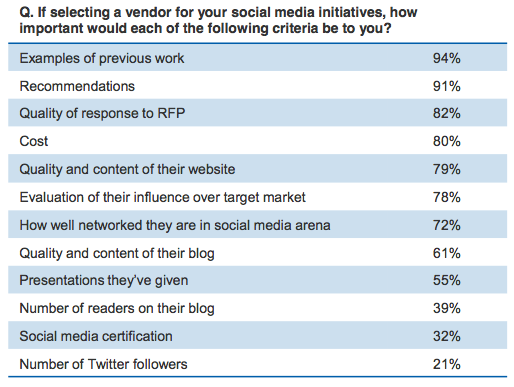 Social media networks are fields of dreams for marketers. With over 500 million active users on Facebook today, there’s no doubt that Facebook is a social media powerhouse. And although Facebook is a social networking favorite, it’s not alone.
Social media networks are fields of dreams for marketers. With over 500 million active users on Facebook today, there’s no doubt that Facebook is a social media powerhouse. And although Facebook is a social networking favorite, it’s not alone.
Marketers are taking note of many different social media opportunities and beginning to implement new social initiatives at a higher rate than ever before. Here are 3 new studies that show social media is still on the rise:
#1: Small Business Doubles Social Media Adoption
One positive result from the economic downturn is the rapid growth of social media marketing.
A recent study, “The State of Small Business Report,” sponsored by Network Solutions, LLC and the University of Maryland’s Robert H. Smith School of Business, points to economic struggles as the catalyst for social media’s rapid popularity.
The study results show that social media usage by small business owners increased from 12% to 24% in just the last year, and almost 1 out of 5 actively uses social media as part of his or her marketing strategy.
Here’s a breakdown of what the small businesses reported as the main uses of social media marketing:
- 75% have a company page on a social networking site
- 69% post status updates or articles of interest on social media sites
- 57% build a network through a site such as LinkedIn
- 54% monitor feedback about the business
- 39% maintain a blog
- 26% tweet about areas of expertise
- 16% use Twitter as a service channel
According to the study, different industries are adopting social media marketing at different rates, and while many industries have started using social media marketing in their efforts to reach more customers, many still have not positioned it as their top priority.
According to the survey, “Professional services firms, real estate businesses and entertainment/food/lodging businesses rely more on email marketing than other types of small businesses. Firms in the education/health/social services sector rely more on social media marketing and direct mail. Not surprisingly, retailers depend more on print and broadcast advertising.”
The report also measured small businesses’ expectations of social media. While 58% feel that social media “met expectations,” 12% feel it has “exceeded expectations,” while 25% feel social media has “fallen short of expectations.”
Some of the reasons given for social media’s shortfalls were:
- 50% feel it has used up more time than expected
- 19% believe social media has lost them money
- 17% feel social media has allowed people to criticize their business
Here’s a breakdown from eMarketer that shows the performance of social media tactics, according to U.S. small businesses:

Overall, social media use by small business is a major growth area. The report says it best: “This dire environment has not stifled innovation. The most successful small businesses are competing by offering superior service and creativity and small businesses are rapidly embracing social media as a way for keeping engaged with customers and tapping knowledge resources.”
Get World-Class Marketing Training — All Year Long!
Are you facing doubt, uncertainty, or overwhelm? The Social Media Marketing Society can help.
Each month, you’ll receive training from trusted marketing experts, covering everything from AI to organic social marketing. When you join, you’ll also get immediate access to:
- A library of 100+ marketing trainings
- A community of like-minded marketers
- Monthly online community meetups
- Relevant news and trends updates

Discover Proven Marketing Strategies and Tips
Want to go even deeper with your marketing? Check out the Social Media Marketing Podcast! Publishing weekly since 2012, the Social Media Marketing Podcast helps you navigate the constantly changing marketing jungle, with expert interviews from marketing pros.
But don’t let the name fool you. This show is about a lot more than just social media marketing. With over 600 episodes and millions of downloads each year, this show has been a trusted source for marketers for well over a decade.
#2: Nearly 20% of Marketing Dollars Will Go to Social Marketing in 5 Years
In just the last 6 months, marketers have shifted their attitudes toward social media marketing spending. This was recently affirmed in the new study, “The CMO Survey”, from Duke University’s Fuqua School of Business and the American Marketing Association. A key finding: Social media marketing budgets continue to rise. According to the results, businesses currently allocate 6% of their marketing budgets to social media, an allotment they expect to increase to 10% during the next year and 18% over the next 5 years.
Back in August 2009, marketers had already planned on devoting more money to social media. However, in February 2010, marketers reported that they plan to allocate one-fifth of their marketing budgets to social media marketing in the next 5 years. This is a definite increase from the 2009 projections. The study features the following comparison from August 2009 to February 2010:
Current marketing budget spending on social media:
August 2009: 3.5%
February 2010: 5.6%
Marketing budget spending on social media in the next 12 months:
August 2009: 6.1%
February 2010: 9.9%
Marketing budget spending on social media in the next 5 years:
August 2009: 13.7%
February 2010: 17.7%
As stated by the director of the survey, Fuqua professor Christine Moorman, “Even though many are still experimenting and learning how best to use social media tools, these results indicate that marketers think social media marketing is here to stay and will play an increasingly important role in their work in acquiring and retaining customers in the future.”
#3: Mastering Social Media: A Top Goal for Marketers
Anderson Analytics and Marketing Executives Networking Group recently released a report titled “Marketing Trends 2010” with some interesting insight into the minds of marketing executives.
When marketing executives were asked to choose the most important trends and buzzwords to pay attention to in 2010, marketing ROI (getting a good return on marketing efforts) was number one, with 58% saying it was the most important trend to keep an eye on. But what’s even more interesting is that social media made the top 10 list, with 42% choosing it as one of the top trends to watch. In addition, 72% said they work for companies that are planning social media initiatives in 2010.
The study also explored social media presence and reported some very interesting findings when comparing personal social media use among marketing executives and their company’s social media use. The table below, courtesy of Anderson Analytics, shows how personal and company presence are not very similar and highlights the key differences. Individual executives are most likely to use networking tools like Facebook and LinkedIn, while companies are more likely to keep a blog than individual executives.

Equally interesting is the consensus on how to carry out the social media initiatives. Marketers turn to internal employees, social media consultants and interactive agencies for support and are less likely to use PR and ad agencies.
When selecting a vendor for social media initiatives, marketing executives focus on the influence over a target market and the extent of a consultant’s network as major deciding factors. The table below shows the total breakdown of the importance of specific criteria when choosing a social media consultant:

These three surveys are great indicators that we will continue to see social media marketing rise and perhaps over time see less of the traditional marketing strategies.
We want to hear from you: Have you seen a major shift to social marketing initiatives in your company? Is there still a hesitancy to make a substantial leap to this new way of marketing or has the shift been an easy transition? Tell us about your experiences below.
Attention Agency Owners, Brand Marketers, and Consultants

Introducing the Marketing Agency Show–our newest podcast designed to explore the struggles of agency marketers.
Join show host and agency owner, Brooke Sellas, as she interviews agency marketers and digs deep into their biggest challenges. Explore topics like navigating rough economic times, leveraging AI, service diversification, client acquisition, and much more.
Just pull up your favorite podcast app, search for Marketing Agency Show and start listening. Or click the button below for more information.

